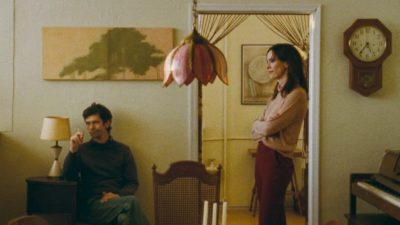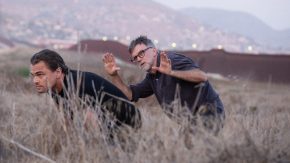Nine years ago, Ivanka Mogilska, a young Bulgarian novelist came to the International Book Festival in Budapest. Back then, she just published her first novel, and nowadays her second novel, Sudden Streets, reached international leadership. For Hungarians, what makes it even more stunning is that Sudden Streets is partly located in Budapest. It also speaks about Bulgarian and Pan-European history, lots of music and love. Now you can read Ivanka Mogilska‘s secrets, behind the glistering scenes: where, when, how and with whom did she write Sudden Streets?
You graduated as a director. How do you think it influences your novels to have studied and worked with films?
Since the novel was published, I’ve heard many times it would be a great idea to make a movie of it. I hope someday, someone will film it for real.
In fact, I didn’t study for a film director but for a drama theater director. I have never been involved in anything closely related to cinematography. Well, not quite anything. Few years after my graduation, as a copywriter, I started to write scripts for TV commercials and I am familiar with the TV sets.
I did a lot of research until Sudden Streets’s story began to take shape. It was involving frequent visits of The Bulgarian National Film Production Studios. I was walking through the different film pavilions, movie sets, the post production studios. I was talking with film directors, producers and, of course, with set designers – at the end my main character is world-renown set designer. I also made few interviews with one of the best Bulgarian movie set designers – Anastas Yanakiev.
My education helped me to elaborate more precisely the motivation of the characters and also to build the structure of the novel.
In your novel, there is a complex storyline of different realities. How did you come to this kind of dramaturgy? Was it a challenge to write it?
The novel has seven story lines and one of the most important is the screenplay Margarita writes for the life of Max Reinhardt – the way it could have been but never was. In fact, her hiring is the base rotational axis for all of the other stories. The nostalgia about something that never happened, the attempt to live through two lives at once, to have everything, to fix all the mistakes, to know if they really were mistakes.
My decision to jump between the times and realities came naturally. In daily life everything happens at the same time. Thе daily routine doesn’t pause for an hour to give you the time to dream and fantasies. On the contrary, you have to interlace the dream and reality, that makes the life more bearable. Perhaps you also have come to realize that while your own little world is being shaked by happiness or sorrow, at this very moment something important is also happening in the little worlds of the people around you. Your life is flowing parallel to mine and to million other people. And sometimes our lives intersect – like the streets do.
I only had to follow the story and the characters. Of course, the first version of the novel was edited 4-5 time until I had the effect I was looking for. But anyway, it’s easier to find you way when you have the goal.
It seems like your characters have real-life counterparts. Is the novel a mixture of reality and fantasy?
Yes, most of the characters have their own real-life counterparts. (For example, the Hungarian musician Roman’s prototype is accordionist of Armenian descent living in Budapest.) I didn’t
tell their life stories. Rather I used their way of thinking, few small facts, gestures, the way they talk, to breathe life into the novel’s characters.
Many readers wrote me they have been googling for Max Reinhardt and found nothing. The truth is there is no such man. The whole story is made-up. It never happened but it could. The perceived credibility is mostly being contributed by the real historical placement of the story, where the truth and fiction are completely entangled.
The story begins at the end of 1950s in the communist Bulgaria. The escape route used by Max is absolutely real and has been used by the bulgarians running to Paris. The refugee camps in Italia and Turkey also existed. You can visit the the russian bookstore in Paris even today. If Reinhardt have lived and shooted films in France, he could have been dating Catherine Deneuve, as mentioned in the novel.
Some of the scenes take place in Budapest. Do you have some connection to the city? Why has it become one of the locations?
I visited Budapest for a first time in 2008 as participant in the meeting of European First Novel Festival during The International Book Festival. I was very impressed by the city. Especially
the nightlife. Each bar and cafe has its own character and charm. You can go around and listen to different bands and musicians. That’s when I did the first scatches of images and places, later used in Sudden Streets. At that time I wasn’t suspecting I will write a second novel and Budapest will be one of the main locations.
I was working on this book 5-6 years. I was giving up, then I was starting again but anyway the story was missing something. All the pieces came together when I heard the music of the accordionist I mentioned before. Right after his concert in Bulgaria the puzzle began to solve and Budapest absolutely naturally became part of it. The jazz club I describe in the book is combination of two bars actually, they exist to this day in your city.
I visited Budapest few more times during the years. Friendships connect me with it, love also has been connecting me to it, and now I hope the novel will start to live its own life in the hands of the Hungarian readers.
A certain music and musical/club culture plays an important role in your book. What does this mean to you personally, or to your characters? Does it have a symbolic/metaphoric meaning?
As I already mentioned, the music was the catalyser of the story – tango, ethno jazz and Django Reinhardt. I was listening certain performances and songs (some of them directly mentioned in the novel) each day before I was starting to write. It was helping me to tune in, to enter the story and follow the characters and see what is going to happen.
When the book went out in Bulgaria the readers started to send me web links to the music they can “hear” playing in Sudden Streets, or to the music they have been listening while reading. I must confess, some of them were far, far away from tango and jazz. The music is definitely one of the entrances to this story and it is different for everyone. I’m curious what the music will be for you – the new readers of Sudden Streets.


























Comments